Health Research: Aboriginal and Torres Strait Islander Peoples
VerifiedAdded on 2022/10/04
|11
|4186
|42
Essay
AI Summary
This essay critically examines ethical principles in health research involving Aboriginal and Torres Strait Islander peoples. It begins by exploring the socioeconomic disadvantages and vulnerabilities faced by these communities, highlighting historical, social, and clinical factors. The essay then delves into relevant ethical guidelines and principles designed to protect this vulnerable population during research, emphasizing the importance of cultural continuity, respect, and informed consent. The second part of the essay critiques a provided journal article, assessing the strengths and weaknesses of the study's methodology and the researchers' application of the research process, with a focus on cultural and spiritual needs. The critique evaluates the clarity of the article's objectives, background, methods, results, and discussion, and suggests revisions to enhance the article's relevance. The essay underscores the need for researchers to prioritize ethical considerations, ensuring that research benefits and respects Aboriginal and Torres Strait Islander communities.
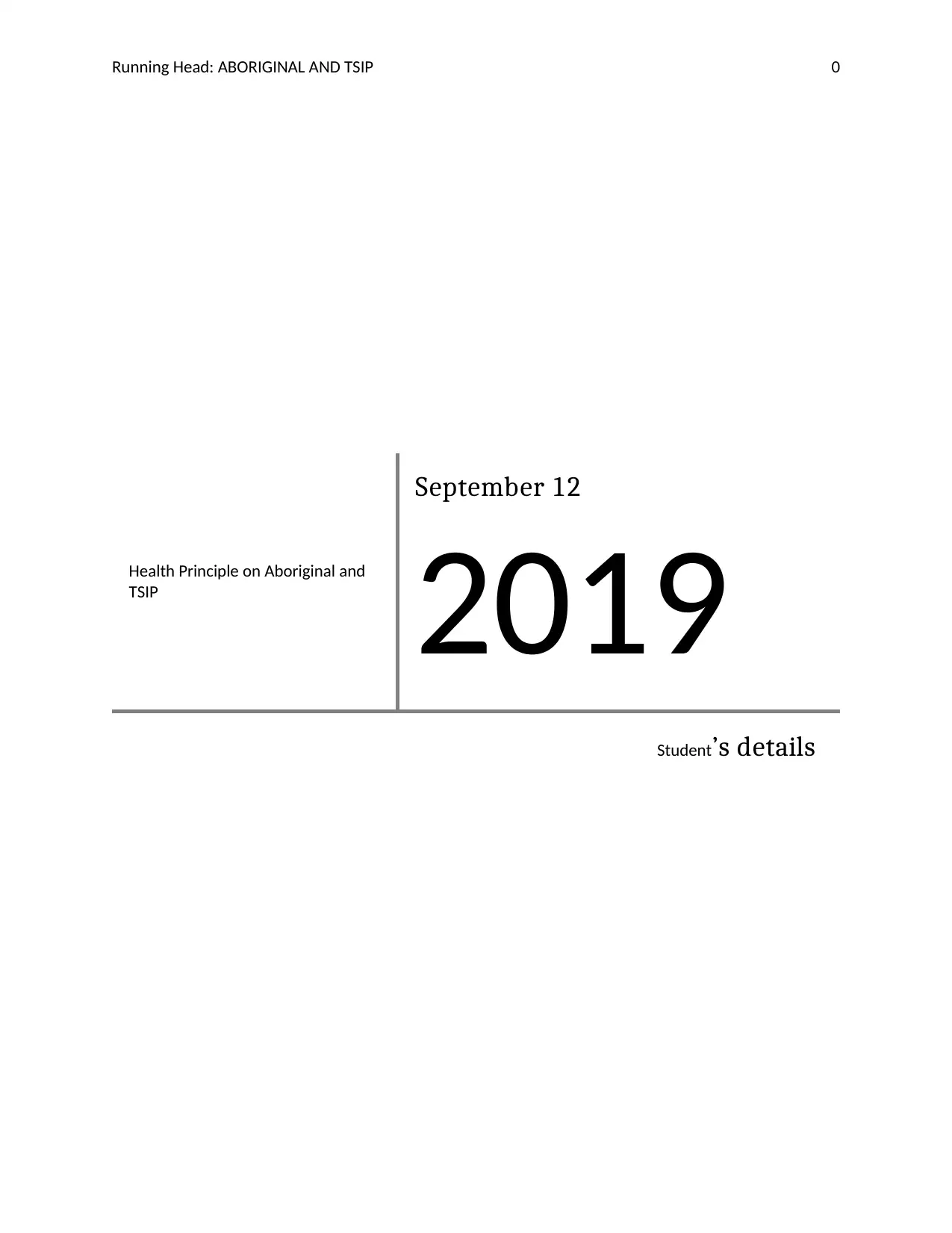
Running Head: ABORIGINAL AND TSIP 0
Health Principle on Aboriginal and
TSIP
September 12
2019
Student’s details
Health Principle on Aboriginal and
TSIP
September 12
2019
Student’s details
Paraphrase This Document
Need a fresh take? Get an instant paraphrase of this document with our AI Paraphraser
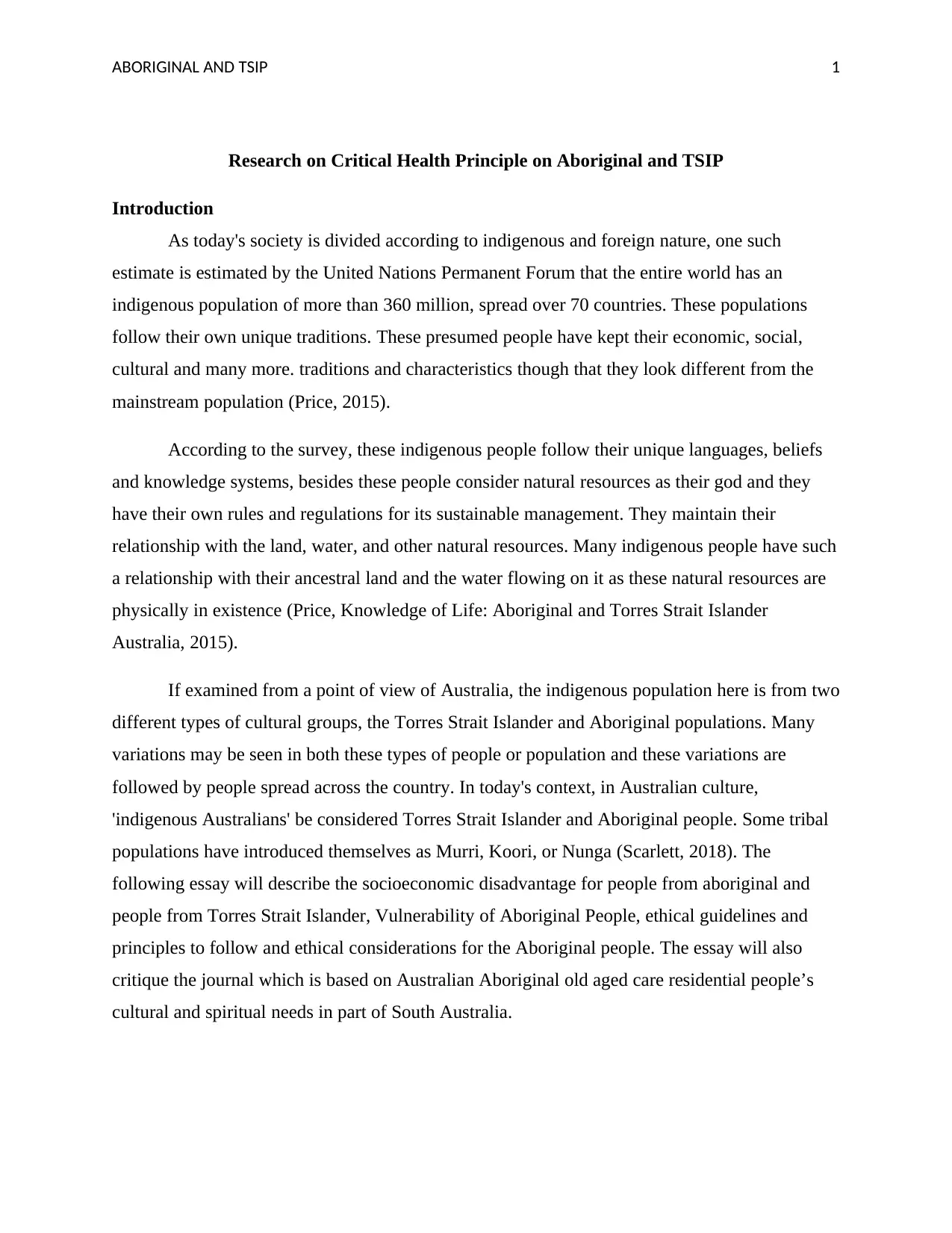
ABORIGINAL AND TSIP 1
Research on Critical Health Principle on Aboriginal and TSIP
Introduction
As today's society is divided according to indigenous and foreign nature, one such
estimate is estimated by the United Nations Permanent Forum that the entire world has an
indigenous population of more than 360 million, spread over 70 countries. These populations
follow their own unique traditions. These presumed people have kept their economic, social,
cultural and many more. traditions and characteristics though that they look different from the
mainstream population (Price, 2015).
According to the survey, these indigenous people follow their unique languages, beliefs
and knowledge systems, besides these people consider natural resources as their god and they
have their own rules and regulations for its sustainable management. They maintain their
relationship with the land, water, and other natural resources. Many indigenous people have such
a relationship with their ancestral land and the water flowing on it as these natural resources are
physically in existence (Price, Knowledge of Life: Aboriginal and Torres Strait Islander
Australia, 2015).
If examined from a point of view of Australia, the indigenous population here is from two
different types of cultural groups, the Torres Strait Islander and Aboriginal populations. Many
variations may be seen in both these types of people or population and these variations are
followed by people spread across the country. In today's context, in Australian culture,
'indigenous Australians' be considered Torres Strait Islander and Aboriginal people. Some tribal
populations have introduced themselves as Murri, Koori, or Nunga (Scarlett, 2018). The
following essay will describe the socioeconomic disadvantage for people from aboriginal and
people from Torres Strait Islander, Vulnerability of Aboriginal People, ethical guidelines and
principles to follow and ethical considerations for the Aboriginal people. The essay will also
critique the journal which is based on Australian Aboriginal old aged care residential people’s
cultural and spiritual needs in part of South Australia.
Research on Critical Health Principle on Aboriginal and TSIP
Introduction
As today's society is divided according to indigenous and foreign nature, one such
estimate is estimated by the United Nations Permanent Forum that the entire world has an
indigenous population of more than 360 million, spread over 70 countries. These populations
follow their own unique traditions. These presumed people have kept their economic, social,
cultural and many more. traditions and characteristics though that they look different from the
mainstream population (Price, 2015).
According to the survey, these indigenous people follow their unique languages, beliefs
and knowledge systems, besides these people consider natural resources as their god and they
have their own rules and regulations for its sustainable management. They maintain their
relationship with the land, water, and other natural resources. Many indigenous people have such
a relationship with their ancestral land and the water flowing on it as these natural resources are
physically in existence (Price, Knowledge of Life: Aboriginal and Torres Strait Islander
Australia, 2015).
If examined from a point of view of Australia, the indigenous population here is from two
different types of cultural groups, the Torres Strait Islander and Aboriginal populations. Many
variations may be seen in both these types of people or population and these variations are
followed by people spread across the country. In today's context, in Australian culture,
'indigenous Australians' be considered Torres Strait Islander and Aboriginal people. Some tribal
populations have introduced themselves as Murri, Koori, or Nunga (Scarlett, 2018). The
following essay will describe the socioeconomic disadvantage for people from aboriginal and
people from Torres Strait Islander, Vulnerability of Aboriginal People, ethical guidelines and
principles to follow and ethical considerations for the Aboriginal people. The essay will also
critique the journal which is based on Australian Aboriginal old aged care residential people’s
cultural and spiritual needs in part of South Australia.
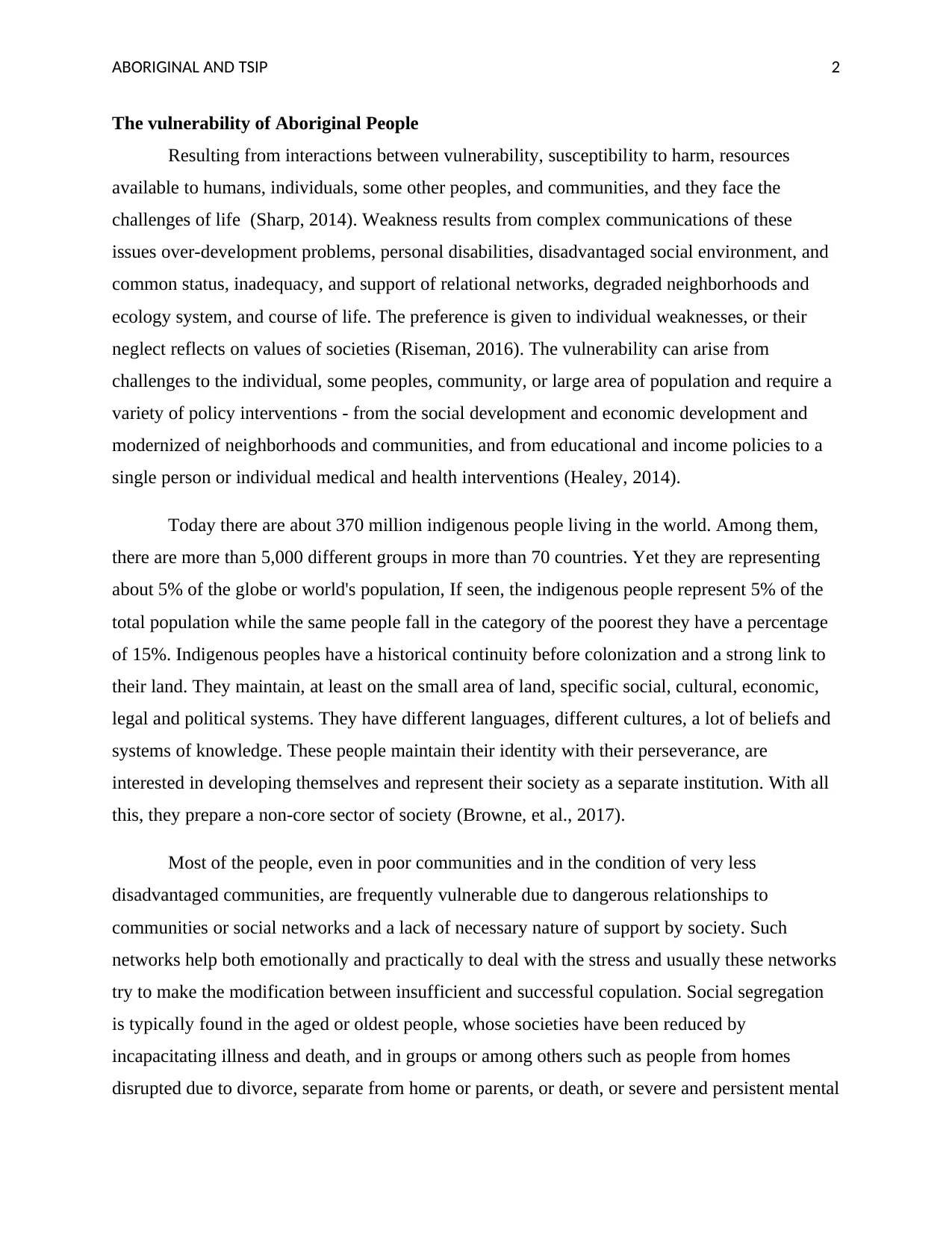
ABORIGINAL AND TSIP 2
The vulnerability of Aboriginal People
Resulting from interactions between vulnerability, susceptibility to harm, resources
available to humans, individuals, some other peoples, and communities, and they face the
challenges of life (Sharp, 2014). Weakness results from complex communications of these
issues over-development problems, personal disabilities, disadvantaged social environment, and
common status, inadequacy, and support of relational networks, degraded neighborhoods and
ecology system, and course of life. The preference is given to individual weaknesses, or their
neglect reflects on values of societies (Riseman, 2016). The vulnerability can arise from
challenges to the individual, some peoples, community, or large area of population and require a
variety of policy interventions - from the social development and economic development and
modernized of neighborhoods and communities, and from educational and income policies to a
single person or individual medical and health interventions (Healey, 2014).
Today there are about 370 million indigenous people living in the world. Among them,
there are more than 5,000 different groups in more than 70 countries. Yet they are representing
about 5% of the globe or world's population, If seen, the indigenous people represent 5% of the
total population while the same people fall in the category of the poorest they have a percentage
of 15%. Indigenous peoples have a historical continuity before colonization and a strong link to
their land. They maintain, at least on the small area of land, specific social, cultural, economic,
legal and political systems. They have different languages, different cultures, a lot of beliefs and
systems of knowledge. These people maintain their identity with their perseverance, are
interested in developing themselves and represent their society as a separate institution. With all
this, they prepare a non-core sector of society (Browne, et al., 2017).
Most of the people, even in poor communities and in the condition of very less
disadvantaged communities, are frequently vulnerable due to dangerous relationships to
communities or social networks and a lack of necessary nature of support by society. Such
networks help both emotionally and practically to deal with the stress and usually these networks
try to make the modification between insufficient and successful copulation. Social segregation
is typically found in the aged or oldest people, whose societies have been reduced by
incapacitating illness and death, and in groups or among others such as people from homes
disrupted due to divorce, separate from home or parents, or death, or severe and persistent mental
The vulnerability of Aboriginal People
Resulting from interactions between vulnerability, susceptibility to harm, resources
available to humans, individuals, some other peoples, and communities, and they face the
challenges of life (Sharp, 2014). Weakness results from complex communications of these
issues over-development problems, personal disabilities, disadvantaged social environment, and
common status, inadequacy, and support of relational networks, degraded neighborhoods and
ecology system, and course of life. The preference is given to individual weaknesses, or their
neglect reflects on values of societies (Riseman, 2016). The vulnerability can arise from
challenges to the individual, some peoples, community, or large area of population and require a
variety of policy interventions - from the social development and economic development and
modernized of neighborhoods and communities, and from educational and income policies to a
single person or individual medical and health interventions (Healey, 2014).
Today there are about 370 million indigenous people living in the world. Among them,
there are more than 5,000 different groups in more than 70 countries. Yet they are representing
about 5% of the globe or world's population, If seen, the indigenous people represent 5% of the
total population while the same people fall in the category of the poorest they have a percentage
of 15%. Indigenous peoples have a historical continuity before colonization and a strong link to
their land. They maintain, at least on the small area of land, specific social, cultural, economic,
legal and political systems. They have different languages, different cultures, a lot of beliefs and
systems of knowledge. These people maintain their identity with their perseverance, are
interested in developing themselves and represent their society as a separate institution. With all
this, they prepare a non-core sector of society (Browne, et al., 2017).
Most of the people, even in poor communities and in the condition of very less
disadvantaged communities, are frequently vulnerable due to dangerous relationships to
communities or social networks and a lack of necessary nature of support by society. Such
networks help both emotionally and practically to deal with the stress and usually these networks
try to make the modification between insufficient and successful copulation. Social segregation
is typically found in the aged or oldest people, whose societies have been reduced by
incapacitating illness and death, and in groups or among others such as people from homes
disrupted due to divorce, separate from home or parents, or death, or severe and persistent mental
⊘ This is a preview!⊘
Do you want full access?
Subscribe today to unlock all pages.

Trusted by 1+ million students worldwide
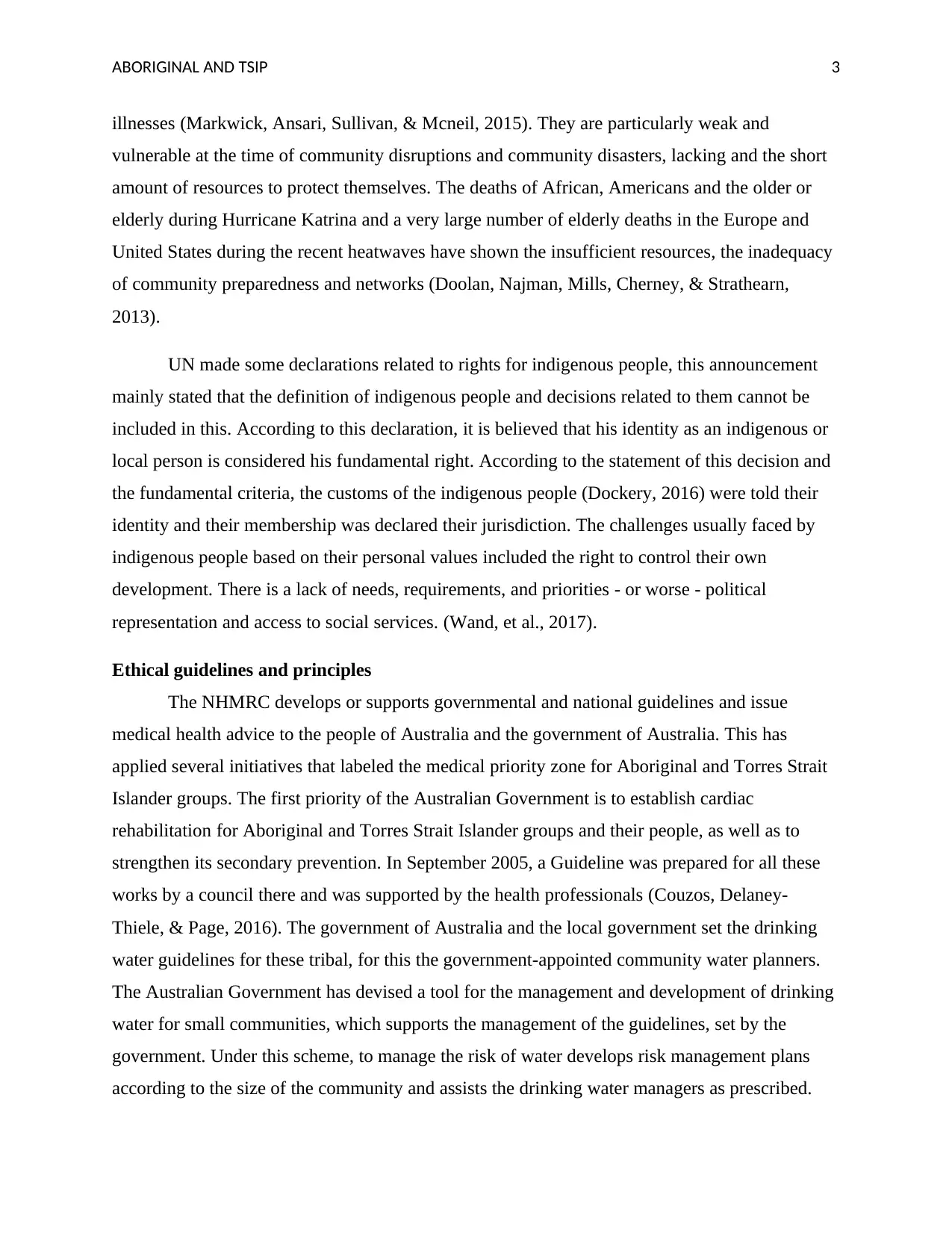
ABORIGINAL AND TSIP 3
illnesses (Markwick, Ansari, Sullivan, & Mcneil, 2015). They are particularly weak and
vulnerable at the time of community disruptions and community disasters, lacking and the short
amount of resources to protect themselves. The deaths of African, Americans and the older or
elderly during Hurricane Katrina and a very large number of elderly deaths in the Europe and
United States during the recent heatwaves have shown the insufficient resources, the inadequacy
of community preparedness and networks (Doolan, Najman, Mills, Cherney, & Strathearn,
2013).
UN made some declarations related to rights for indigenous people, this announcement
mainly stated that the definition of indigenous people and decisions related to them cannot be
included in this. According to this declaration, it is believed that his identity as an indigenous or
local person is considered his fundamental right. According to the statement of this decision and
the fundamental criteria, the customs of the indigenous people (Dockery, 2016) were told their
identity and their membership was declared their jurisdiction. The challenges usually faced by
indigenous people based on their personal values included the right to control their own
development. There is a lack of needs, requirements, and priorities - or worse - political
representation and access to social services. (Wand, et al., 2017).
Ethical guidelines and principles
The NHMRC develops or supports governmental and national guidelines and issue
medical health advice to the people of Australia and the government of Australia. This has
applied several initiatives that labeled the medical priority zone for Aboriginal and Torres Strait
Islander groups. The first priority of the Australian Government is to establish cardiac
rehabilitation for Aboriginal and Torres Strait Islander groups and their people, as well as to
strengthen its secondary prevention. In September 2005, a Guideline was prepared for all these
works by a council there and was supported by the health professionals (Couzos, Delaney‐
Thiele, & Page, 2016). The government of Australia and the local government set the drinking
water guidelines for these tribal, for this the government-appointed community water planners.
The Australian Government has devised a tool for the management and development of drinking
water for small communities, which supports the management of the guidelines, set by the
government. Under this scheme, to manage the risk of water develops risk management plans
according to the size of the community and assists the drinking water managers as prescribed.
illnesses (Markwick, Ansari, Sullivan, & Mcneil, 2015). They are particularly weak and
vulnerable at the time of community disruptions and community disasters, lacking and the short
amount of resources to protect themselves. The deaths of African, Americans and the older or
elderly during Hurricane Katrina and a very large number of elderly deaths in the Europe and
United States during the recent heatwaves have shown the insufficient resources, the inadequacy
of community preparedness and networks (Doolan, Najman, Mills, Cherney, & Strathearn,
2013).
UN made some declarations related to rights for indigenous people, this announcement
mainly stated that the definition of indigenous people and decisions related to them cannot be
included in this. According to this declaration, it is believed that his identity as an indigenous or
local person is considered his fundamental right. According to the statement of this decision and
the fundamental criteria, the customs of the indigenous people (Dockery, 2016) were told their
identity and their membership was declared their jurisdiction. The challenges usually faced by
indigenous people based on their personal values included the right to control their own
development. There is a lack of needs, requirements, and priorities - or worse - political
representation and access to social services. (Wand, et al., 2017).
Ethical guidelines and principles
The NHMRC develops or supports governmental and national guidelines and issue
medical health advice to the people of Australia and the government of Australia. This has
applied several initiatives that labeled the medical priority zone for Aboriginal and Torres Strait
Islander groups. The first priority of the Australian Government is to establish cardiac
rehabilitation for Aboriginal and Torres Strait Islander groups and their people, as well as to
strengthen its secondary prevention. In September 2005, a Guideline was prepared for all these
works by a council there and was supported by the health professionals (Couzos, Delaney‐
Thiele, & Page, 2016). The government of Australia and the local government set the drinking
water guidelines for these tribal, for this the government-appointed community water planners.
The Australian Government has devised a tool for the management and development of drinking
water for small communities, which supports the management of the guidelines, set by the
government. Under this scheme, to manage the risk of water develops risk management plans
according to the size of the community and assists the drinking water managers as prescribed.
Paraphrase This Document
Need a fresh take? Get an instant paraphrase of this document with our AI Paraphraser
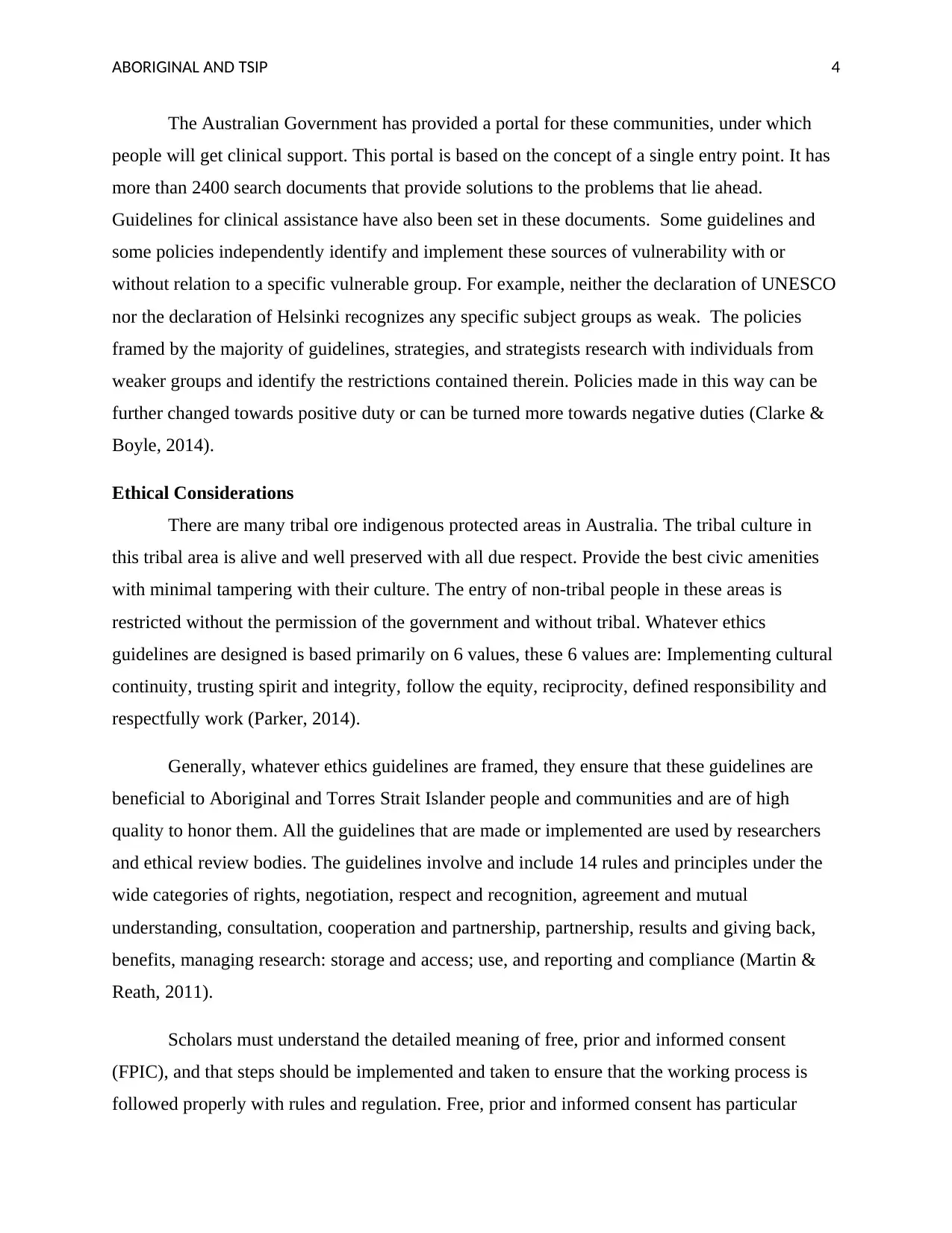
ABORIGINAL AND TSIP 4
The Australian Government has provided a portal for these communities, under which
people will get clinical support. This portal is based on the concept of a single entry point. It has
more than 2400 search documents that provide solutions to the problems that lie ahead.
Guidelines for clinical assistance have also been set in these documents. Some guidelines and
some policies independently identify and implement these sources of vulnerability with or
without relation to a specific vulnerable group. For example, neither the declaration of UNESCO
nor the declaration of Helsinki recognizes any specific subject groups as weak. The policies
framed by the majority of guidelines, strategies, and strategists research with individuals from
weaker groups and identify the restrictions contained therein. Policies made in this way can be
further changed towards positive duty or can be turned more towards negative duties (Clarke &
Boyle, 2014).
Ethical Considerations
There are many tribal ore indigenous protected areas in Australia. The tribal culture in
this tribal area is alive and well preserved with all due respect. Provide the best civic amenities
with minimal tampering with their culture. The entry of non-tribal people in these areas is
restricted without the permission of the government and without tribal. Whatever ethics
guidelines are designed is based primarily on 6 values, these 6 values are: Implementing cultural
continuity, trusting spirit and integrity, follow the equity, reciprocity, defined responsibility and
respectfully work (Parker, 2014).
Generally, whatever ethics guidelines are framed, they ensure that these guidelines are
beneficial to Aboriginal and Torres Strait Islander people and communities and are of high
quality to honor them. All the guidelines that are made or implemented are used by researchers
and ethical review bodies. The guidelines involve and include 14 rules and principles under the
wide categories of rights, negotiation, respect and recognition, agreement and mutual
understanding, consultation, cooperation and partnership, partnership, results and giving back,
benefits, managing research: storage and access; use, and reporting and compliance (Martin &
Reath, 2011).
Scholars must understand the detailed meaning of free, prior and informed consent
(FPIC), and that steps should be implemented and taken to ensure that the working process is
followed properly with rules and regulation. Free, prior and informed consent has particular
The Australian Government has provided a portal for these communities, under which
people will get clinical support. This portal is based on the concept of a single entry point. It has
more than 2400 search documents that provide solutions to the problems that lie ahead.
Guidelines for clinical assistance have also been set in these documents. Some guidelines and
some policies independently identify and implement these sources of vulnerability with or
without relation to a specific vulnerable group. For example, neither the declaration of UNESCO
nor the declaration of Helsinki recognizes any specific subject groups as weak. The policies
framed by the majority of guidelines, strategies, and strategists research with individuals from
weaker groups and identify the restrictions contained therein. Policies made in this way can be
further changed towards positive duty or can be turned more towards negative duties (Clarke &
Boyle, 2014).
Ethical Considerations
There are many tribal ore indigenous protected areas in Australia. The tribal culture in
this tribal area is alive and well preserved with all due respect. Provide the best civic amenities
with minimal tampering with their culture. The entry of non-tribal people in these areas is
restricted without the permission of the government and without tribal. Whatever ethics
guidelines are designed is based primarily on 6 values, these 6 values are: Implementing cultural
continuity, trusting spirit and integrity, follow the equity, reciprocity, defined responsibility and
respectfully work (Parker, 2014).
Generally, whatever ethics guidelines are framed, they ensure that these guidelines are
beneficial to Aboriginal and Torres Strait Islander people and communities and are of high
quality to honor them. All the guidelines that are made or implemented are used by researchers
and ethical review bodies. The guidelines involve and include 14 rules and principles under the
wide categories of rights, negotiation, respect and recognition, agreement and mutual
understanding, consultation, cooperation and partnership, partnership, results and giving back,
benefits, managing research: storage and access; use, and reporting and compliance (Martin &
Reath, 2011).
Scholars must understand the detailed meaning of free, prior and informed consent
(FPIC), and that steps should be implemented and taken to ensure that the working process is
followed properly with rules and regulation. Free, prior and informed consent has particular

ABORIGINAL AND TSIP 5
means that the agreement ought to be free from pressure or coercion, and ensure that people of
indigenous are fully known with the particular details and risks which are seen before, of the
proposed research (Wieland, 2014).
The concept of vulnerability that has been implemented shows inconsistency between the
guidelines and the policies present in under certain circumstances. In some other cases (CIOMS,
Australian National Statement, TCPS2, Belmont Report), other applications from some other
fundamentals, weakened research by which this problem was dealt with. For example, in TCPS
2, under the concept of vulnerability, under any circumstances respect will be shown for the
main points of the policy and the main principles of the policy. Along with this, they were
compelled to worry for every person, welfare of those people, and their justice. In some cases,
vulnerabilities related to their form, represent concerns related to them as fundamental
obligations and fundamental principles (Stevens, et al., 2016).
Journal critique
The title of the journal Exploring Aboriginal aged care residents’ cultural and spiritual
needs in South Australia is very clear and appropriate. The title is clearly reflecting the objective
of the Journal. The abstract of the journal article is specifically about the topic. In the abstract,
author described the summary of every important part of the article and these parts are
background, methods, results, conclusion, and keywords. In this Journal, Author started the
article with background in which author clearly described the cultural components of Aboriginal
people. The author cited every concept of the article which makes it relevant. The discussion of
the journal article is relevant as author clearly showed the findings of the study in which he
described how aged aboriginal people need extra care and attention in South Australia. In the
article, author’s statements are also clear and he mentioned the reasons for shortage of support to
aboriginal people. The author mentioned that lack of funding can be supposed the main reason
for lack of support to Aboriginal residents. But at this point author only gave the assumptions,
not the clarity. Hence, it is creating little confusions. In the discussion of the topic, author
described every aspect related to the objective of the article. The author can revise the discussion
of the articles as per today’s context but the article is clearly mentioned every aspect which is
fulfilling the objective of article.
means that the agreement ought to be free from pressure or coercion, and ensure that people of
indigenous are fully known with the particular details and risks which are seen before, of the
proposed research (Wieland, 2014).
The concept of vulnerability that has been implemented shows inconsistency between the
guidelines and the policies present in under certain circumstances. In some other cases (CIOMS,
Australian National Statement, TCPS2, Belmont Report), other applications from some other
fundamentals, weakened research by which this problem was dealt with. For example, in TCPS
2, under the concept of vulnerability, under any circumstances respect will be shown for the
main points of the policy and the main principles of the policy. Along with this, they were
compelled to worry for every person, welfare of those people, and their justice. In some cases,
vulnerabilities related to their form, represent concerns related to them as fundamental
obligations and fundamental principles (Stevens, et al., 2016).
Journal critique
The title of the journal Exploring Aboriginal aged care residents’ cultural and spiritual
needs in South Australia is very clear and appropriate. The title is clearly reflecting the objective
of the Journal. The abstract of the journal article is specifically about the topic. In the abstract,
author described the summary of every important part of the article and these parts are
background, methods, results, conclusion, and keywords. In this Journal, Author started the
article with background in which author clearly described the cultural components of Aboriginal
people. The author cited every concept of the article which makes it relevant. The discussion of
the journal article is relevant as author clearly showed the findings of the study in which he
described how aged aboriginal people need extra care and attention in South Australia. In the
article, author’s statements are also clear and he mentioned the reasons for shortage of support to
aboriginal people. The author mentioned that lack of funding can be supposed the main reason
for lack of support to Aboriginal residents. But at this point author only gave the assumptions,
not the clarity. Hence, it is creating little confusions. In the discussion of the topic, author
described every aspect related to the objective of the article. The author can revise the discussion
of the articles as per today’s context but the article is clearly mentioned every aspect which is
fulfilling the objective of article.
⊘ This is a preview!⊘
Do you want full access?
Subscribe today to unlock all pages.

Trusted by 1+ million students worldwide

ABORIGINAL AND TSIP 6
Critique of Exploring Australian Aboriginal aged care resident’s cultural and spiritual
needs in South Australia
In this article, the author focused on cultural and spiritual requirements and needs of
Aboriginal aged care residents in South Australia. The author stated that Cultural care involves
subjects of geography, history, and ethnicity, all of which are important factors when caring for
aged people. Culture care discusses and reacts to someone who is experiencing pain and
depression, often due to location, kinship, land, and separation from soul or spirit. Smith noted
the absence of training and qualifications for instructors in relation to cultural and spiritual care
in Australia. Although some researchers have indicated the needs of cultural care for older
people, they are less aware of maintaining these needs of tribal residents in senior care centers
(Sivertsen, Harrington, & Hamiduzzaman, 2019).
The average age of tribal or aboriginal people living in institutions was 73 years on June
30, 2017, compared to 85 years for non-aboriginal. There are about 2,672 residential care
facilities operating in Australia. Of these, 1% (24 institutions) had at least 50% of their clients
identified as Aboriginal or Torres Strait Islanders. In general, tribal members provide care done
through numerous senior care programs. But, some senior care providers concentrate on
providing culturally flexible and appropriate models for older Australian Aborigines.
In the journal article, the author mentioned some methods to fulfill the needs of
aboriginal aged care residents. Thorne, Macdonald-Ames, and Kirkham (1997) believe that
formal research and interpretation for anyone is a front structure for qualitative investigation.
They told that any interview should be understood in a deep way and based on them, based on
existing knowledge, should conclude and make a reliable analysis of the interview. Based on the
depth of the study that was done, it was found that a qualitative framework should be constructed
because the relationship of those who take care of the aged person was also included in it. This
interview is concluded on the basis of the questions asked in it (Zhang, Valenti, & Britt, 2014).
To fulfill the spiritual and cultural needs of the aboriginal aged care residents, the authors
conducted the interviews. Altogether, the scholars contacted elderly care facilities where the
population consisted of Aboriginal people; two facilities have 100% indigenous people, and one
facility has about 10%, indigenous people. Two of these facilities have tribal guards/nurses and
another caretaker on staff. The questions about research for participants in this study are what are
Critique of Exploring Australian Aboriginal aged care resident’s cultural and spiritual
needs in South Australia
In this article, the author focused on cultural and spiritual requirements and needs of
Aboriginal aged care residents in South Australia. The author stated that Cultural care involves
subjects of geography, history, and ethnicity, all of which are important factors when caring for
aged people. Culture care discusses and reacts to someone who is experiencing pain and
depression, often due to location, kinship, land, and separation from soul or spirit. Smith noted
the absence of training and qualifications for instructors in relation to cultural and spiritual care
in Australia. Although some researchers have indicated the needs of cultural care for older
people, they are less aware of maintaining these needs of tribal residents in senior care centers
(Sivertsen, Harrington, & Hamiduzzaman, 2019).
The average age of tribal or aboriginal people living in institutions was 73 years on June
30, 2017, compared to 85 years for non-aboriginal. There are about 2,672 residential care
facilities operating in Australia. Of these, 1% (24 institutions) had at least 50% of their clients
identified as Aboriginal or Torres Strait Islanders. In general, tribal members provide care done
through numerous senior care programs. But, some senior care providers concentrate on
providing culturally flexible and appropriate models for older Australian Aborigines.
In the journal article, the author mentioned some methods to fulfill the needs of
aboriginal aged care residents. Thorne, Macdonald-Ames, and Kirkham (1997) believe that
formal research and interpretation for anyone is a front structure for qualitative investigation.
They told that any interview should be understood in a deep way and based on them, based on
existing knowledge, should conclude and make a reliable analysis of the interview. Based on the
depth of the study that was done, it was found that a qualitative framework should be constructed
because the relationship of those who take care of the aged person was also included in it. This
interview is concluded on the basis of the questions asked in it (Zhang, Valenti, & Britt, 2014).
To fulfill the spiritual and cultural needs of the aboriginal aged care residents, the authors
conducted the interviews. Altogether, the scholars contacted elderly care facilities where the
population consisted of Aboriginal people; two facilities have 100% indigenous people, and one
facility has about 10%, indigenous people. Two of these facilities have tribal guards/nurses and
another caretaker on staff. The questions about research for participants in this study are what are
Paraphrase This Document
Need a fresh take? Get an instant paraphrase of this document with our AI Paraphraser
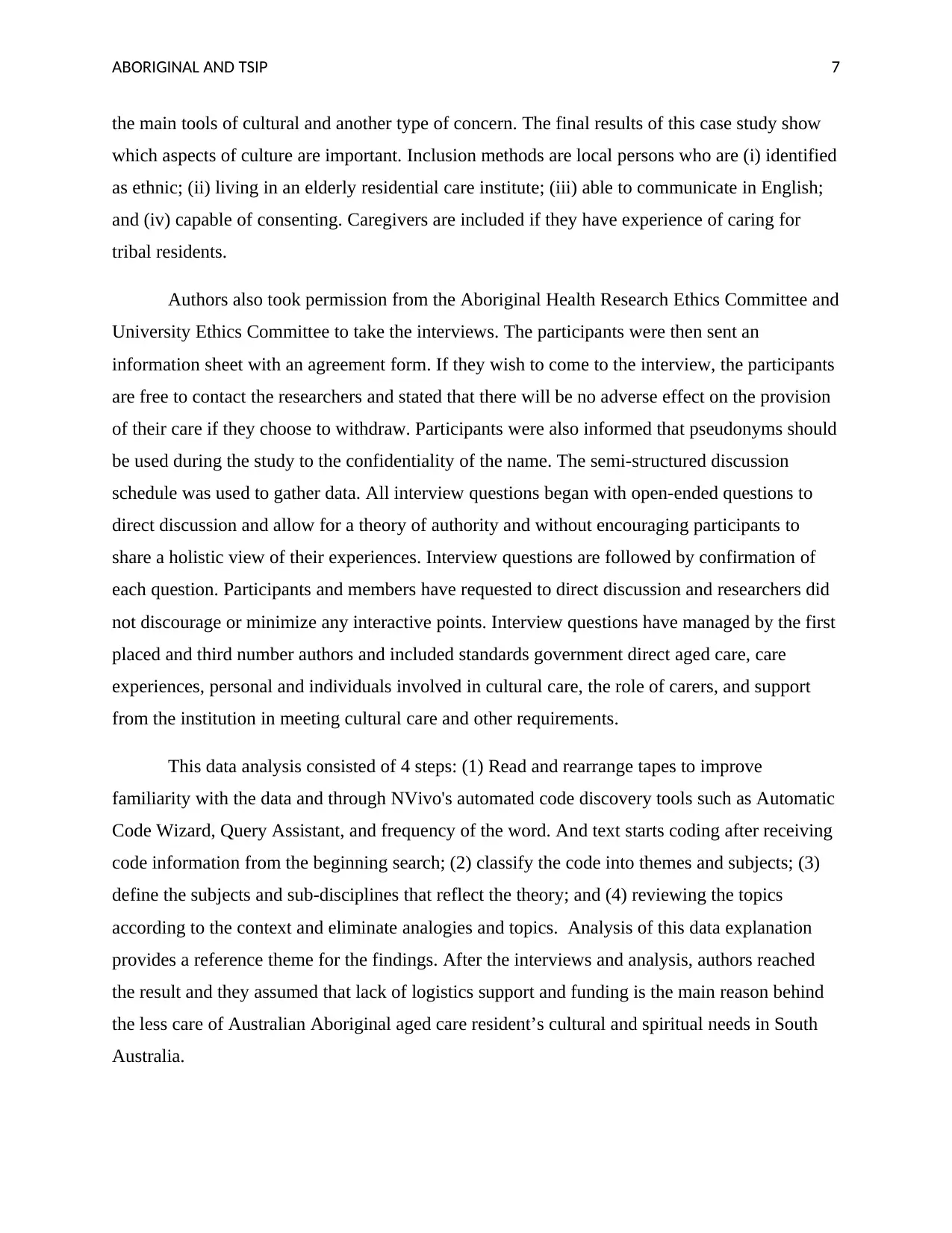
ABORIGINAL AND TSIP 7
the main tools of cultural and another type of concern. The final results of this case study show
which aspects of culture are important. Inclusion methods are local persons who are (i) identified
as ethnic; (ii) living in an elderly residential care institute; (iii) able to communicate in English;
and (iv) capable of consenting. Caregivers are included if they have experience of caring for
tribal residents.
Authors also took permission from the Aboriginal Health Research Ethics Committee and
University Ethics Committee to take the interviews. The participants were then sent an
information sheet with an agreement form. If they wish to come to the interview, the participants
are free to contact the researchers and stated that there will be no adverse effect on the provision
of their care if they choose to withdraw. Participants were also informed that pseudonyms should
be used during the study to the confidentiality of the name. The semi-structured discussion
schedule was used to gather data. All interview questions began with open-ended questions to
direct discussion and allow for a theory of authority and without encouraging participants to
share a holistic view of their experiences. Interview questions are followed by confirmation of
each question. Participants and members have requested to direct discussion and researchers did
not discourage or minimize any interactive points. Interview questions have managed by the first
placed and third number authors and included standards government direct aged care, care
experiences, personal and individuals involved in cultural care, the role of carers, and support
from the institution in meeting cultural care and other requirements.
This data analysis consisted of 4 steps: (1) Read and rearrange tapes to improve
familiarity with the data and through NVivo's automated code discovery tools such as Automatic
Code Wizard, Query Assistant, and frequency of the word. And text starts coding after receiving
code information from the beginning search; (2) classify the code into themes and subjects; (3)
define the subjects and sub-disciplines that reflect the theory; and (4) reviewing the topics
according to the context and eliminate analogies and topics. Analysis of this data explanation
provides a reference theme for the findings. After the interviews and analysis, authors reached
the result and they assumed that lack of logistics support and funding is the main reason behind
the less care of Australian Aboriginal aged care resident’s cultural and spiritual needs in South
Australia.
the main tools of cultural and another type of concern. The final results of this case study show
which aspects of culture are important. Inclusion methods are local persons who are (i) identified
as ethnic; (ii) living in an elderly residential care institute; (iii) able to communicate in English;
and (iv) capable of consenting. Caregivers are included if they have experience of caring for
tribal residents.
Authors also took permission from the Aboriginal Health Research Ethics Committee and
University Ethics Committee to take the interviews. The participants were then sent an
information sheet with an agreement form. If they wish to come to the interview, the participants
are free to contact the researchers and stated that there will be no adverse effect on the provision
of their care if they choose to withdraw. Participants were also informed that pseudonyms should
be used during the study to the confidentiality of the name. The semi-structured discussion
schedule was used to gather data. All interview questions began with open-ended questions to
direct discussion and allow for a theory of authority and without encouraging participants to
share a holistic view of their experiences. Interview questions are followed by confirmation of
each question. Participants and members have requested to direct discussion and researchers did
not discourage or minimize any interactive points. Interview questions have managed by the first
placed and third number authors and included standards government direct aged care, care
experiences, personal and individuals involved in cultural care, the role of carers, and support
from the institution in meeting cultural care and other requirements.
This data analysis consisted of 4 steps: (1) Read and rearrange tapes to improve
familiarity with the data and through NVivo's automated code discovery tools such as Automatic
Code Wizard, Query Assistant, and frequency of the word. And text starts coding after receiving
code information from the beginning search; (2) classify the code into themes and subjects; (3)
define the subjects and sub-disciplines that reflect the theory; and (4) reviewing the topics
according to the context and eliminate analogies and topics. Analysis of this data explanation
provides a reference theme for the findings. After the interviews and analysis, authors reached
the result and they assumed that lack of logistics support and funding is the main reason behind
the less care of Australian Aboriginal aged care resident’s cultural and spiritual needs in South
Australia.
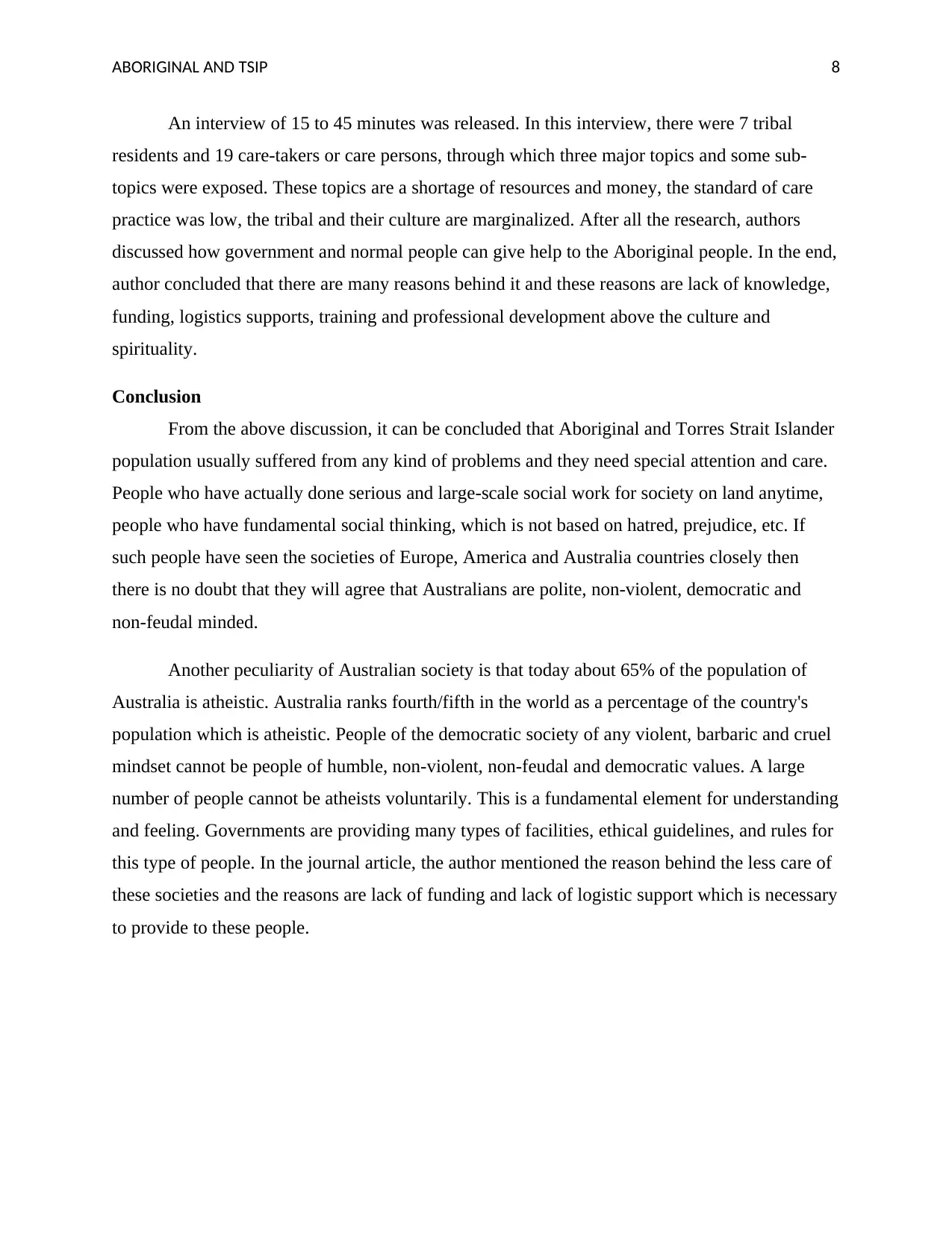
ABORIGINAL AND TSIP 8
An interview of 15 to 45 minutes was released. In this interview, there were 7 tribal
residents and 19 care-takers or care persons, through which three major topics and some sub-
topics were exposed. These topics are a shortage of resources and money, the standard of care
practice was low, the tribal and their culture are marginalized. After all the research, authors
discussed how government and normal people can give help to the Aboriginal people. In the end,
author concluded that there are many reasons behind it and these reasons are lack of knowledge,
funding, logistics supports, training and professional development above the culture and
spirituality.
Conclusion
From the above discussion, it can be concluded that Aboriginal and Torres Strait Islander
population usually suffered from any kind of problems and they need special attention and care.
People who have actually done serious and large-scale social work for society on land anytime,
people who have fundamental social thinking, which is not based on hatred, prejudice, etc. If
such people have seen the societies of Europe, America and Australia countries closely then
there is no doubt that they will agree that Australians are polite, non-violent, democratic and
non-feudal minded.
Another peculiarity of Australian society is that today about 65% of the population of
Australia is atheistic. Australia ranks fourth/fifth in the world as a percentage of the country's
population which is atheistic. People of the democratic society of any violent, barbaric and cruel
mindset cannot be people of humble, non-violent, non-feudal and democratic values. A large
number of people cannot be atheists voluntarily. This is a fundamental element for understanding
and feeling. Governments are providing many types of facilities, ethical guidelines, and rules for
this type of people. In the journal article, the author mentioned the reason behind the less care of
these societies and the reasons are lack of funding and lack of logistic support which is necessary
to provide to these people.
An interview of 15 to 45 minutes was released. In this interview, there were 7 tribal
residents and 19 care-takers or care persons, through which three major topics and some sub-
topics were exposed. These topics are a shortage of resources and money, the standard of care
practice was low, the tribal and their culture are marginalized. After all the research, authors
discussed how government and normal people can give help to the Aboriginal people. In the end,
author concluded that there are many reasons behind it and these reasons are lack of knowledge,
funding, logistics supports, training and professional development above the culture and
spirituality.
Conclusion
From the above discussion, it can be concluded that Aboriginal and Torres Strait Islander
population usually suffered from any kind of problems and they need special attention and care.
People who have actually done serious and large-scale social work for society on land anytime,
people who have fundamental social thinking, which is not based on hatred, prejudice, etc. If
such people have seen the societies of Europe, America and Australia countries closely then
there is no doubt that they will agree that Australians are polite, non-violent, democratic and
non-feudal minded.
Another peculiarity of Australian society is that today about 65% of the population of
Australia is atheistic. Australia ranks fourth/fifth in the world as a percentage of the country's
population which is atheistic. People of the democratic society of any violent, barbaric and cruel
mindset cannot be people of humble, non-violent, non-feudal and democratic values. A large
number of people cannot be atheists voluntarily. This is a fundamental element for understanding
and feeling. Governments are providing many types of facilities, ethical guidelines, and rules for
this type of people. In the journal article, the author mentioned the reason behind the less care of
these societies and the reasons are lack of funding and lack of logistic support which is necessary
to provide to these people.
⊘ This is a preview!⊘
Do you want full access?
Subscribe today to unlock all pages.

Trusted by 1+ million students worldwide
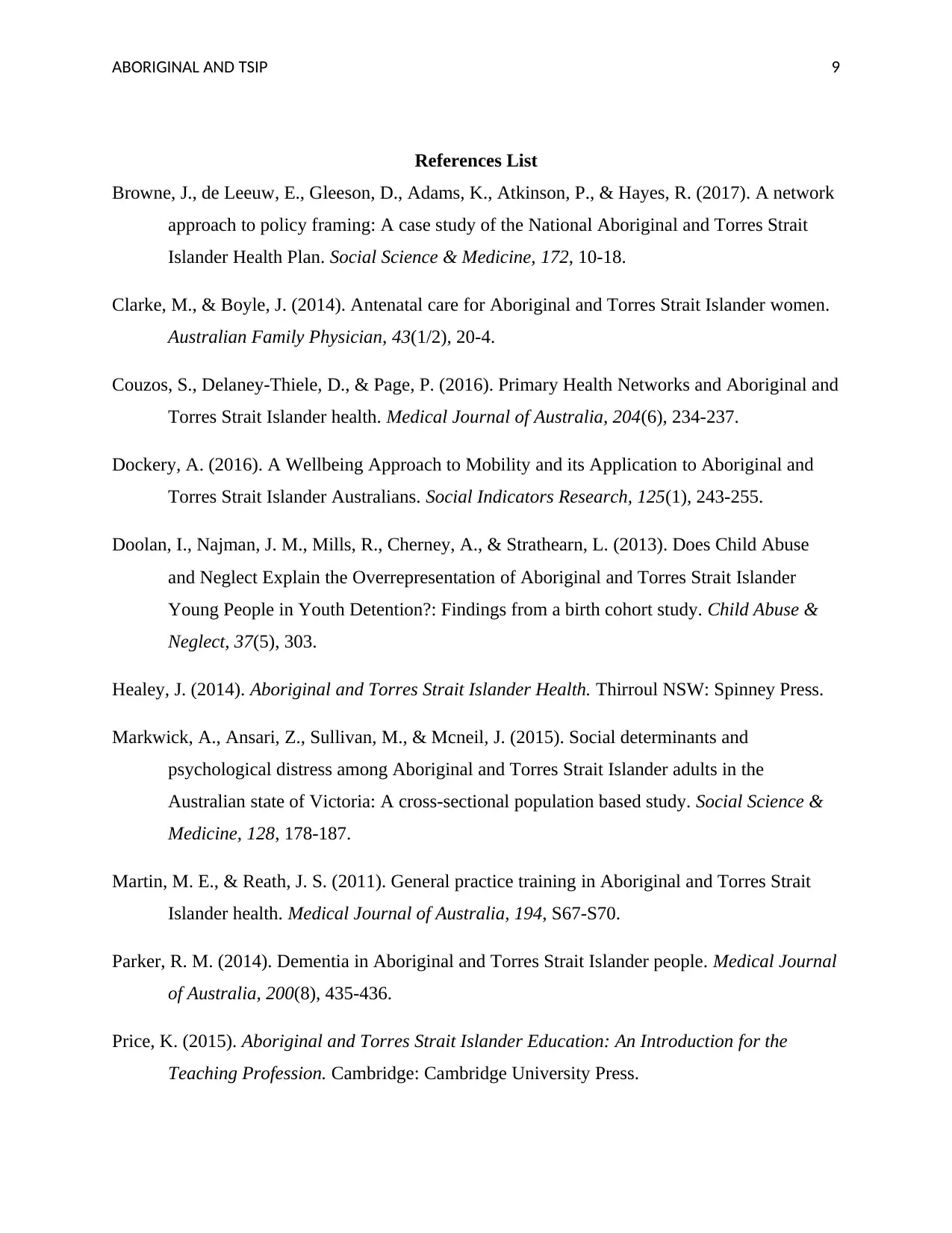
ABORIGINAL AND TSIP 9
References List
Browne, J., de Leeuw, E., Gleeson, D., Adams, K., Atkinson, P., & Hayes, R. (2017). A network
approach to policy framing: A case study of the National Aboriginal and Torres Strait
Islander Health Plan. Social Science & Medicine, 172, 10-18.
Clarke, M., & Boyle, J. (2014). Antenatal care for Aboriginal and Torres Strait Islander women.
Australian Family Physician, 43(1/2), 20-4.
Couzos, S., Delaney‐Thiele, D., & Page, P. (2016). Primary Health Networks and Aboriginal and
Torres Strait Islander health. Medical Journal of Australia, 204(6), 234-237.
Dockery, A. (2016). A Wellbeing Approach to Mobility and its Application to Aboriginal and
Torres Strait Islander Australians. Social Indicators Research, 125(1), 243-255.
Doolan, I., Najman, J. M., Mills, R., Cherney, A., & Strathearn, L. (2013). Does Child Abuse
and Neglect Explain the Overrepresentation of Aboriginal and Torres Strait Islander
Young People in Youth Detention?: Findings from a birth cohort study. Child Abuse &
Neglect, 37(5), 303.
Healey, J. (2014). Aboriginal and Torres Strait Islander Health. Thirroul NSW: Spinney Press.
Markwick, A., Ansari, Z., Sullivan, M., & Mcneil, J. (2015). Social determinants and
psychological distress among Aboriginal and Torres Strait Islander adults in the
Australian state of Victoria: A cross-sectional population based study. Social Science &
Medicine, 128, 178-187.
Martin, M. E., & Reath, J. S. (2011). General practice training in Aboriginal and Torres Strait
Islander health. Medical Journal of Australia, 194, S67-S70.
Parker, R. M. (2014). Dementia in Aboriginal and Torres Strait Islander people. Medical Journal
of Australia, 200(8), 435-436.
Price, K. (2015). Aboriginal and Torres Strait Islander Education: An Introduction for the
Teaching Profession. Cambridge: Cambridge University Press.
References List
Browne, J., de Leeuw, E., Gleeson, D., Adams, K., Atkinson, P., & Hayes, R. (2017). A network
approach to policy framing: A case study of the National Aboriginal and Torres Strait
Islander Health Plan. Social Science & Medicine, 172, 10-18.
Clarke, M., & Boyle, J. (2014). Antenatal care for Aboriginal and Torres Strait Islander women.
Australian Family Physician, 43(1/2), 20-4.
Couzos, S., Delaney‐Thiele, D., & Page, P. (2016). Primary Health Networks and Aboriginal and
Torres Strait Islander health. Medical Journal of Australia, 204(6), 234-237.
Dockery, A. (2016). A Wellbeing Approach to Mobility and its Application to Aboriginal and
Torres Strait Islander Australians. Social Indicators Research, 125(1), 243-255.
Doolan, I., Najman, J. M., Mills, R., Cherney, A., & Strathearn, L. (2013). Does Child Abuse
and Neglect Explain the Overrepresentation of Aboriginal and Torres Strait Islander
Young People in Youth Detention?: Findings from a birth cohort study. Child Abuse &
Neglect, 37(5), 303.
Healey, J. (2014). Aboriginal and Torres Strait Islander Health. Thirroul NSW: Spinney Press.
Markwick, A., Ansari, Z., Sullivan, M., & Mcneil, J. (2015). Social determinants and
psychological distress among Aboriginal and Torres Strait Islander adults in the
Australian state of Victoria: A cross-sectional population based study. Social Science &
Medicine, 128, 178-187.
Martin, M. E., & Reath, J. S. (2011). General practice training in Aboriginal and Torres Strait
Islander health. Medical Journal of Australia, 194, S67-S70.
Parker, R. M. (2014). Dementia in Aboriginal and Torres Strait Islander people. Medical Journal
of Australia, 200(8), 435-436.
Price, K. (2015). Aboriginal and Torres Strait Islander Education: An Introduction for the
Teaching Profession. Cambridge: Cambridge University Press.
Paraphrase This Document
Need a fresh take? Get an instant paraphrase of this document with our AI Paraphraser
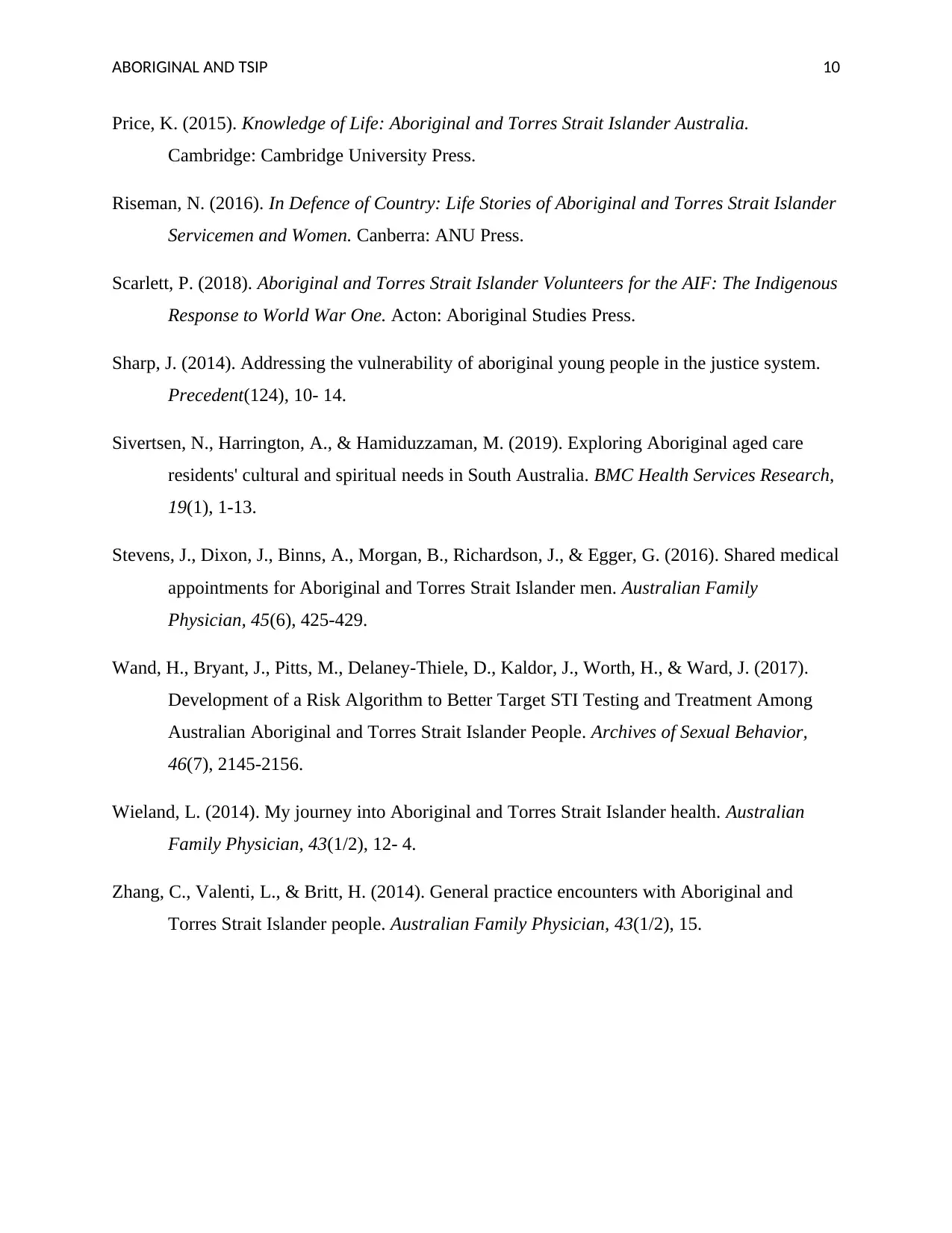
ABORIGINAL AND TSIP 10
Price, K. (2015). Knowledge of Life: Aboriginal and Torres Strait Islander Australia.
Cambridge: Cambridge University Press.
Riseman, N. (2016). In Defence of Country: Life Stories of Aboriginal and Torres Strait Islander
Servicemen and Women. Canberra: ANU Press.
Scarlett, P. (2018). Aboriginal and Torres Strait Islander Volunteers for the AIF: The Indigenous
Response to World War One. Acton: Aboriginal Studies Press.
Sharp, J. (2014). Addressing the vulnerability of aboriginal young people in the justice system.
Precedent(124), 10- 14.
Sivertsen, N., Harrington, A., & Hamiduzzaman, M. (2019). Exploring Aboriginal aged care
residents' cultural and spiritual needs in South Australia. BMC Health Services Research,
19(1), 1-13.
Stevens, J., Dixon, J., Binns, A., Morgan, B., Richardson, J., & Egger, G. (2016). Shared medical
appointments for Aboriginal and Torres Strait Islander men. Australian Family
Physician, 45(6), 425-429.
Wand, H., Bryant, J., Pitts, M., Delaney-Thiele, D., Kaldor, J., Worth, H., & Ward, J. (2017).
Development of a Risk Algorithm to Better Target STI Testing and Treatment Among
Australian Aboriginal and Torres Strait Islander People. Archives of Sexual Behavior,
46(7), 2145-2156.
Wieland, L. (2014). My journey into Aboriginal and Torres Strait Islander health. Australian
Family Physician, 43(1/2), 12- 4.
Zhang, C., Valenti, L., & Britt, H. (2014). General practice encounters with Aboriginal and
Torres Strait Islander people. Australian Family Physician, 43(1/2), 15.
Price, K. (2015). Knowledge of Life: Aboriginal and Torres Strait Islander Australia.
Cambridge: Cambridge University Press.
Riseman, N. (2016). In Defence of Country: Life Stories of Aboriginal and Torres Strait Islander
Servicemen and Women. Canberra: ANU Press.
Scarlett, P. (2018). Aboriginal and Torres Strait Islander Volunteers for the AIF: The Indigenous
Response to World War One. Acton: Aboriginal Studies Press.
Sharp, J. (2014). Addressing the vulnerability of aboriginal young people in the justice system.
Precedent(124), 10- 14.
Sivertsen, N., Harrington, A., & Hamiduzzaman, M. (2019). Exploring Aboriginal aged care
residents' cultural and spiritual needs in South Australia. BMC Health Services Research,
19(1), 1-13.
Stevens, J., Dixon, J., Binns, A., Morgan, B., Richardson, J., & Egger, G. (2016). Shared medical
appointments for Aboriginal and Torres Strait Islander men. Australian Family
Physician, 45(6), 425-429.
Wand, H., Bryant, J., Pitts, M., Delaney-Thiele, D., Kaldor, J., Worth, H., & Ward, J. (2017).
Development of a Risk Algorithm to Better Target STI Testing and Treatment Among
Australian Aboriginal and Torres Strait Islander People. Archives of Sexual Behavior,
46(7), 2145-2156.
Wieland, L. (2014). My journey into Aboriginal and Torres Strait Islander health. Australian
Family Physician, 43(1/2), 12- 4.
Zhang, C., Valenti, L., & Britt, H. (2014). General practice encounters with Aboriginal and
Torres Strait Islander people. Australian Family Physician, 43(1/2), 15.
1 out of 11
Related Documents
Your All-in-One AI-Powered Toolkit for Academic Success.
+13062052269
info@desklib.com
Available 24*7 on WhatsApp / Email
![[object Object]](/_next/static/media/star-bottom.7253800d.svg)
Unlock your academic potential
Copyright © 2020–2025 A2Z Services. All Rights Reserved. Developed and managed by ZUCOL.





